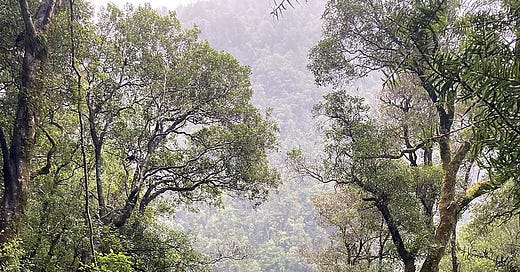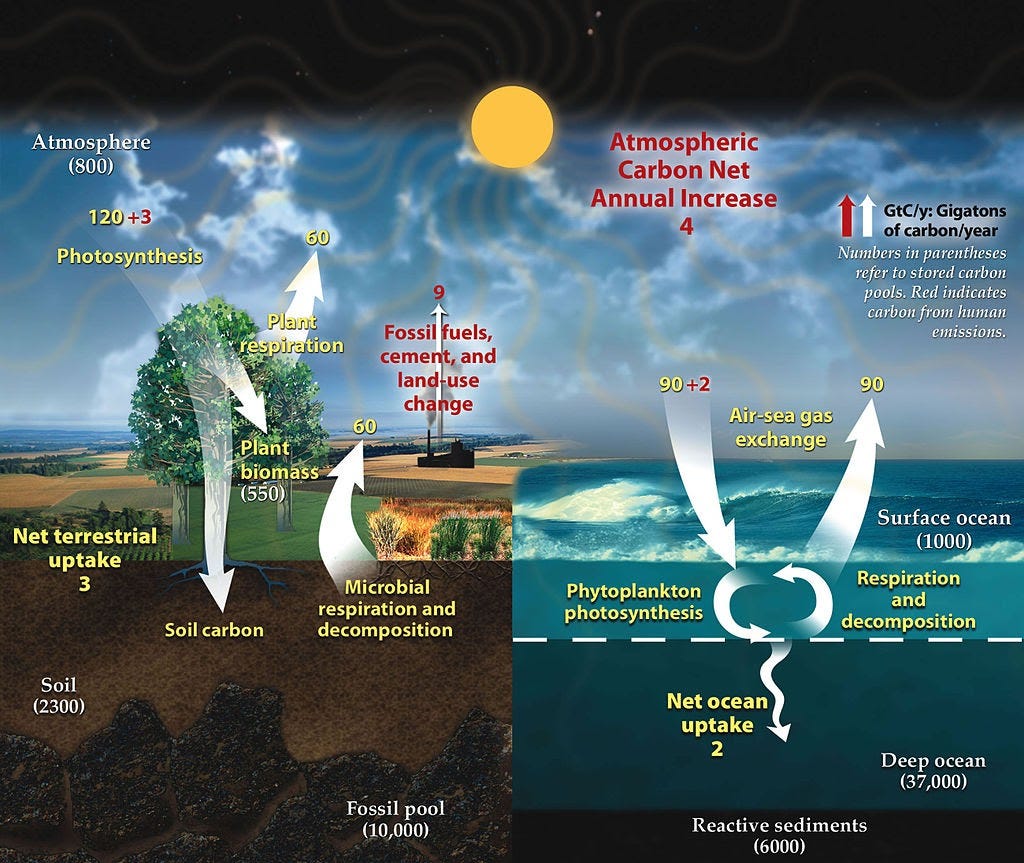Here is a climate policy proposal…
Let’s link carbon pricing to nature.
Put a price on CO2 emissions and use the funds raised to implement nature-based solutions for sequestering carbon. Directly link the price of CO2 to soil carbon and ecosystem services in a zero-waste, circular economy model that puts atmospheric carbon where it is supposed to go: into healthy ecosystems.
Carbon Pricing for Nature could get us 70% of the way to net-zero.
Global annual emissions are currently around 36 billion tons of carbon dioxide or just under 10 tons of carbon. It takes 3.667 tons of CO2 to make one ton of C. 1 billion tons is a gigaton (Gt).
Soil scientists say that sequestering 4-5 gigatons of soil carbon globally is an ambitious but reasonable target, which represents 40% of global emissions. Farmlands, grasslands, forests, wetlands, and ecosystems generally can all contribute to biological sequestration.
Economists say that a carbon price would reduce CO2 emissions by 30% through fuel switching, swapping out coal and petroleum for natural gas, synthetics, and biofuels.
Together, that is 70% of the carbon problem, leaving all the new technology of wind, solar, nuclear, carbon capture, and efficiency for the remaining 30%, which combined, can certainly exceed that target.
The end game should be to raise Mother Nature’s deep capacity to absorb CO2 while lowering fossil fuel emissions down to the minimum, at which point, CO2 emissions will be below net-zero. This is an achievable goal by mid-century.
Carbon Pricing for Nature would create a massive new economy for ecosystem services with the money going to farmers, ranchers, landowners both public and private, plus biologists, land managers, and other professionals.
The system would create new financial incentives that encourage the protection of ecosystems and counterbalance the enduring pressure to extract natural resources from Mother Earth for human profit.
Let’s put a price on ecosystems and nature. Create a new economic model with reliable income flowing into natural lands that incentivize and reward their protection and nurturing. Encourage people to create interlinking ecosystem corridors with robust biodiversity, wildlife habitat, carbon sequestration, and freshwater production.
Market Size
To get a sense of the potential global market of Carbon Pricing for Nature, this chart shows a range of target carbon emissions and possible carbon pricing, high to low.
1 ton of soil carbon per hectare (2.5 acres) represents the floor for biological sequestration, so the chart shows maximum land use. Soil types and vegetation vary dramatically, and some lands can sequester 20 tons C per hectare. A few tons of soil carbon per hectare would be a new cash crop similar in value to other agricultural commodities.
We could aim for an annual $1 trillion market going into ecosystem renewal. As emissions go down, the price can go up to hit the target. 3Gt C at $100 CO2 is over $1 trillion.
Soil carbon here is a proxy for ecosystem services and land management practices. CO2 for soil C is a figure of speech. The money would be paid out based on a score of ecosystem services, not on the single variable of soil carbon.
Direct measurements of soil carbon fluxes are highly complex and transient on a daily basis and would be unreliable for financial transactions. Soil carbon should be one variable on a scorecard of ecological health. Detailed carbon sequestration must be measured at the ecosystem scale where large-scale carbon fluxes can be observed.
An MRV (monitoring, reporting, and verification) system would need to be created that is trusted, reliable, and fair to track land stewardship and enable financial transactions.
Carbon Price
Carbon pricing is used in a variety of systems around the world and we have enough experience now to identify models that are effective versus those that are flawed. Carbon taxes and emissions trading systems (ETS) both exist in various jurisdictions.
The best voluntary carbon markets are already doing what I describe in discrete regions. But most carbon taxes to date have typically been too low to drive emissions down, while many ETS have been undermined by poorly designed offsets that are not defensible in carbon terms.
Carbon Tax and Dividend is a politically popular model with a number of groups across the political spectrum offering detailed proposals. Under these proposals, a tax on carbon emissions is applied and the funds are returned to the taxpayers in the form of dividend payments. The purpose of the payments is to offset any rising costs in energy resulting from the tax, which may be viewed as regressive and disproportionately impacting the poor.
My proposal of Carbon Pricing for Nature would work the same on the front end, but the funds would be used for ecosystem renewal rather than dividend payments to citizens. The purpose is to use the revenues to solve the carbon problem by creating ecosystem sequestration sinks to match the reductions in emissions. All living creatures benefit from an improved environment.
From the liberal side, the Citizens Climate Lobby proposes a carbon tax that starts low, $15, and is increased annually until emissions are satisfactorily reduced. Their studies indicate that CO2 emissions reductions from the USA of 52% below 1990 levels.
We propose an initial fee of $15/metric ton on the CO2 equivalent emissions of fossil fuels, escalating by $10/metric ton each year.
A study from REMI shows that carbon fee-and-dividend will reduce CO2 emissions 52% below 1990 levels in 20 years.
From the conservative side, the Climate Leadership Council includes many industrial corporations and oil & gas majors like ExxonMobil and Shell. This proposal is important because it marks a price that industry is willing to pay and should be seen as an opening offer in a political negotiation. The CLC proposal would also return the funds raised as dividend payments to citizens.
The Council’s plan – based on a $43/ton carbon tax, implemented in 2021 – would reduce emissions by around 32% compared to 2005 and about 23% compared to 2016, meaning the United States would exceed the upper end of its 2025 Paris commitment.
Both of these organizations publish economic studies on their websites and there is a robust field of literature on carbon pricing. The consensus is that carbon pricing in a range of $30-$100/ton CO2 is effective in reducing emissions without distorting energy markets or consumption.
Soil Carbon Capacity
Diagram adapted from U.S. Dept of Energy
This diagram of the fast carbon cycle shows the movement of carbon between land, atmosphere, and oceans in billions of metric tons of carbon per year. Yellow numbers are natural fluxes, red are human contributions, white are stored carbon. All values normalized to C.
This chart is a few years old and anthropogenic emissions have climbed slightly, but it is still basically accurate. There is a more detailed carbon cycle chart from the UN IPCC below.
Global human CO2 emissions from fossil fuels and other activities are 9+Gt C. Approximately 3Gt is currently absorbed biologically through plant photosynthesis. 2Gt C is absorbed into the oceans, raising acidity levels and bleaching corals. Leaving 4+Gt accumulating in the atmosphere causing global warming/climate change.
Readers should note that the vegetative carbon cycle is 120Gt C up and down every year, compared to 9-10Gt C from human activities. The Earth’s carbon cycle is much larger than anthropogenic carbon emissions. Plant biomass contains 550Gt C and soils contain 2300Gt C, compared to 800Gt C in the atmosphere.
Humans have been undermining Nature’s capacity to absorb CO2 by systematically cutting apart ecosystems. We need to reverse this trend by changing the financial value of intact ecosystems.
Raising biological sequestration by 4%, from 120Gt C per year to 124.8Gt C, in combination with reducing emissions by half would get us to net-zero.
There are numerous studies demonstrating that raising soil sequestration by 4-5Gt C globally is a reasonable target. The French government created the “4 per 1000 Initiative” to promote the improvement of soils for food security and climate. They reference increasing soils (1500Gt C in the first 30cm) by .4%, or 6Gt C annually.
An annual growth rate of 0.4% in the soil carbon stocks, or 4‰ per year, in the first 30-40 cm of soil, would significantly reduce the CO2 concentration in the atmosphere related to human activities. - 4p1000
This chart of the global carbon cycle is from the UN IPCC Climate Change 2013 report. It is more detailed (and harder to read) than the more simplified chart above.
PgC = petagram carbon = gigaton carbon = Gt C
Market Failure - Market Future
The challenge in improving biological sequestration lies in the fact that ecosystems are not given any financial value in today’s markets. Ecosystem services are not priced at all, which is a market failure. Ecosystems provide us with fresh air, clean water, wildlife habitat, bountiful plant resources, and much more, but there is no reward in the market for these services. Even worse, there is generally no penalty for using nature as a dumping ground for pollution.
In today’s markets, land is only valued for the commodities that are extracted from it, wood, farm crops, animals, etc. A forest owner only makes money from the trees and animals they harvest. A farmer is only paid for the crops he harvests (plus gov’t farm supports). No one gets paid for protecting or improving the land so that it provides greater ecosystem services.
A land-owner is implicitly encouraged to clear cut forests to develop the land for homes, farms, and ranches and is effectively penalized in the form of property taxes if they leave the forests intact. This is a market failure that fails to recognize the implicit value of clean air, water, and habitat.
Attaching carbon pricing back to ecosystem renewal could rectify this market failure.
We need policies to incentivize and reward ecosystem renewal and pay for ecosystem services. Carbon pricing for nature could inject roughly $1 trillion annually into global ecosystems, creating an entirely new sector of the economy and new professions, and setting us on a path to net-zero carbon emissions.







